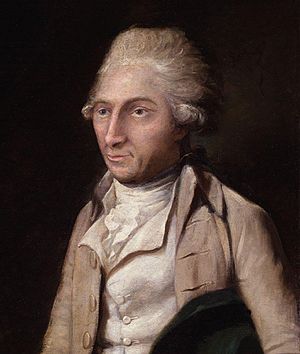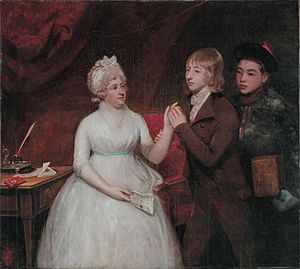Sir George Staunton, 1st Baronet facts for kids
Sir George Leonard Staunton, 1st Baronet (born April 10, 1737 – died January 14, 1801) was an important person from Ireland who worked as a botanist, a doctor, and a diplomat. He also worked for the East India Company, which was a big trading company.
Contents
Early Life and Career
George Leonard Staunton was born in a place called Cargin in County Galway, Ireland. His father was Colonel George Staunton. George went to school in France, at a special college in Toulouse. He became a doctor in 1758. He also studied medicine at another school in Montpellier. Later, he earned a special law degree from the University of Oxford in 1790.
Working in the West Indies
Sir George first worked as a doctor in the British West Indies. There, he acquired large areas of land for farming in places like Grenada and Dominica. He then changed his career to law. In 1779, he became the Attorney-General in Grenada. This meant he was the main lawyer for the government there.
Diplomatic Missions
In 1784, Sir George went to Madras (which is now in India). He went with his good friend, Lord Macartney. They were there to make peace with a ruler named Tipu Sultan. Because of his good work, Sir George was given a special title: a baronet of Ireland, in 1785. This is a title of honor, like a knight. In 1787, he was also chosen to be a member of the Royal Society, which is a famous group of scientists.
The China Embassy
In 1793, Sir George Staunton was chosen to be the Secretary for a special British trip to China. This trip was called the Macartney Embassy, and Lord Macartney led it. The goal was to meet the Chinese Emperor and try to make trade agreements.
Even though the mission did not get new trade deals from China, it was still very important. The people on the trip learned a lot about China. They wrote down many detailed observations about the country.
Later Life and Legacy
Sir George Staunton passed away in London on January 14, 1801. He was buried in Westminster Abbey, a very famous church. A statue was put there to remember him.
His only son, George Thomas Staunton, inherited his title and his homes.
Published Works
After the Macartney Embassy returned from China, Sir George Staunton was asked to write the official story of their journey.
An Authentic Account of an Embassy
His book was published in 1797. It was called An Authentic Account of an Embassy from the King of Great Britain to the Emperor of China. This book had many volumes and was based on notes from Lord Macartney and Sir Erasmus Gower. Sir Joseph Banks, who was the head of the Royal Society, helped choose and arrange the pictures for this important book.



